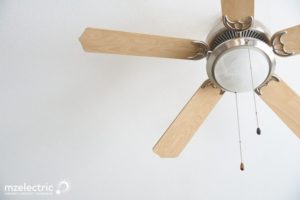Pros & Cons of Ceiling Fans Installed in Your Home
During the hot summer months, there are many steps homeowners can take in order to keep their homes comfortable and cool. For many, utilizing a ceiling fan is part of this process. Ceiling fans aren’t only an effective way to cool off a room, they also function as a decorative addition to any interior design décor layouts. Therefore, it’s no surprise that the vast majority of homes have at least one ceiling fan installed if not multiple.
 You may be thinking, point me to residential electricians near me and let’s get this fan installed! However, there are a few facts to consider before calling your local electricians and installing a ceiling fan. Some homeowners swear by the functionality and efficiency of their ceiling fan. Others swear that running the AC is the only way to truly cool off a room. The truth is that there is validity to both sides, and the ceiling fan is not without its own set of benefits and drawbacks. If you’re considering installing a new ceiling fan in your home but aren’t sure if it’s the right choice for you and your preferences, here are some of the pros and cons associated with ceiling fans.
You may be thinking, point me to residential electricians near me and let’s get this fan installed! However, there are a few facts to consider before calling your local electricians and installing a ceiling fan. Some homeowners swear by the functionality and efficiency of their ceiling fan. Others swear that running the AC is the only way to truly cool off a room. The truth is that there is validity to both sides, and the ceiling fan is not without its own set of benefits and drawbacks. If you’re considering installing a new ceiling fan in your home but aren’t sure if it’s the right choice for you and your preferences, here are some of the pros and cons associated with ceiling fans.
Ceiling Fan Installation: The Pros and Cons
Pro: Ceiling fans can lower your energy bills. Nearly every homeowner can agree that lower bills are a positive thing. Therefore, a decreased energy bill is a perfectly acceptable reason to install a ceiling fan. Often, the reason that a room feels warm or stuffy is the sheer fact that the air within the room has become stagnant and poorly circulated. Though ceiling fans can’t blow cold air into the room like an AC unit can, they make sure that the air within the room is circulated properly, leading the room to feel more comfortable and keeping the temperature more consistent.
Ceiling fans require very little power to run, and when used in tandem with an AC unit in the summer, you can keep the thermostat at a higher temperature while still remaining perfectly comfortable. Your bills will be lower, your family will stay cool, and the working life of your AC system will be extended as it won’t have to work so hard to maintain a low temperature in the hot summer months. Ask your local electricians exactly how much you could be saving by adding ceiling fans to your home.
Pro: It’s more efficient than a standing fan. Some people prefer to use individual fans to cool specific areas in their home or even to blow air directly onto them if they tend to overheat. Though it can be convenient to be able to move a fan around wherever you want it to be, it can also become exhausting to have to move the fan whenever you need better air circulation in a new specific area, as standing fans don’t typically have a very wide range of influence.
Ceiling fans are inherently designed to provide air ventilation to the room at large. Not only will you no longer have to worry about moving your individual fan around, but the ceiling fan will also do a better job at cooling the entire room and keeping the air moving so that it can’t stagnate in any specific spot. Plus, a ceiling fan can’t be accidentally knocked over and curious kids and pets can’t get their hair suck in the blades, so you’ll have some peace of mind with the added element of safety.
Pro: It can be used in an outdoor space. If your home electrician suggested that you install an outdoor AC unit, you would think that he was crazy. One of the biggest faux pas you can make as a homeowner is to run your AC when there’s any chance of it leaking out an open window or door, not to mention running in a completely outdoor space. However, patios, porches, and sunrooms can get warm and stuffy too, which is where the ceiling fan comes into play.
Ceiling fans aren’t adding any filtered air to space, they’re simply circulating the air that’s already there, causing the space to feel cooler and less stagnant. Therefore, a ceiling fan is perfectly acceptable in an outdoor space as it will keep the space feeling fresh and cool without releasing any additional, filtered air into the atmosphere. Fans are very inexpensive to run, so you can leave the fan on all summer afternoon without worrying about driving up your energy bill. Plus, ceiling fans are a great way to keep insects away from your outdoor lounge space with increased air circulation.
Con: They can be a bit noisy. A ceiling fan working in perfect condition shouldn’t make any audible sounds at all. However, just like any electrical appliance, they require upkeep in order to keep functioning as they should, and during most electrical inspections, the ceiling fan, unfortunately, gets looked over. The more ceiling fan maintenance is ignored during the routine electrical repairs performed on your home, the squeakier the fan is likely to get.
Over time, the blades can loosen slightly, causing the sound of the fan’s motor to become more and more audible. Though fans rarely pose any real danger of falling or coming apart, the sounds can become irritating, especially if the fan is located in a bedroom or other location where quiet is needed. If you decide to install a ceiling fan, make sure your home electrician takes a look at it during every routine appointment for electrical repairs.
Con: They can add marginal amounts of heat to a room. Ceiling fans are designed to improve airflow and circulation within a room, leading to a more comfortable and cooler space. However, the fact that ceiling fans use electric motors means that the functionality of the motors naturally adds some heat to the room.
If the room in which you plan to install your ceiling fan is on the larger side, the small amounts of heat created by the fan’s motor probably won’t make much of a difference in the overall cooling effect that the fan has on the space. However, in a smaller room, you may notice the small amount of heat added, especially if the temperature outside is particularly high. In situations like this, an AC unit may be more effective as all the mechanical functionality is happening out of sight, and only filtered, chilled air is entering the room.
Con: They can be difficult to clean. Any fixture that’s out of reach is going to be a pain to keep clean, and a ceiling fan is no exception. Not only will you need a step stool or possibly a small ladder to reach the blades, but you’ll also need to use a special tool to properly clean the blades and the central hub without damaging or loosening them.
You can purchase special ceiling fan cleaning wands that are able to extend several feet, but you may still need some sort of boost to be able to reach and you won’t be able to see what you’re cleaning. Plus, if your ceiling fan has any sort of lighting installation, cleaning or changing the bulb will be a pain as well.
Though ceiling fans come with their fair share of drawbacks, the benefits can be significant, especially in terms of saving money on energy bills. Where can I find an electrician near me to get started on my ceiling fan installation, you may ask? Look no further than MZ Electric. We proudly provide electrical inspections, outlet and panel installation and repair, and lighting and ceiling fan installation and repair, to name a few. Schedule an appointment for your ceiling fan installation today with MZ Electric.
